Mindsets, tools and practices are on hand to help instil agility and adaptability into everything that we do, writes Adam Kingl.
We are living in an age of exponential change. But despite being well-versed in narratives about shifts in landscape, industry, market needs and redundant strategies, familiarity with the challenge does not necessarily create a solution.
What do we have to do as leaders to navigate these waters? What skills do we require to keep our organisations relevant and successful in the 21st century? There are mindsets, tools and practices that we can use for ourselves, and in the development of others, to make adaptability and agility a habit.
We may find three barriers to adaptability, regardless of industry or company size:
1. The organisational culture punishes failure, or at least attaches a strong stigma to failure. As a result, the priority is for perfection and predictability.
New practices, processes, products or services that we create are generally only tiny incremental adjustments or improvements to what already exists. Such an enterprise rarely develops the sort of game-changing innovations that create exponential rewards and disrupt its industry. Thus the first area for an organisation to work on is their attitude to adaptability. It is not possible to be both error-free and agile.
2. People don’t have clarity about what change is supposed to look like, which is a huge reason that companies struggle to adapt. Memos encouraging employees to be more ‘agile’ and ‘innovative’ aren’t enough – clear direction is needed.
Since routines and habits are difficult to disrupt at the best of times, it is incumbent on leaders not only to set direction but to suggest (not dictate) a vision for what a new direction could resemble, how it might impact day-to-day work, and what behaviours are encouraged.
3. People don’t have a chance to practice adaptability.
It can be immensely helpful to suggest lenses through which leaders and teams can practise adaptability and innovation with a little more focus. For example, a team could run a 24-hour hackathon where they create experiments and then prototypes of innovations that they wish to develop. That activity automatically moves the organisational needle forward in terms of enhancing its creative capacity.
Similarly, a department could conduct interviews with customers, suppliers and partners about emerging trends they’re seeing in the marketplace. This exercise would break that team out of its internal perspective. How many times do we try to adapt to a new world, but only discuss the potential responses among a small set of colleagues? Yet we decry that we keep coming up with the same solutions to any problem. It’s probably because we’re drawing from a toolkit that rarely refreshes.
Change usually feels like a difficult, drawn-out, top-down, military campaign instead of an organic, market-driven, exciting prospect. It can be the latter, but we must question some of our long-held management paradigms about leading change that have fostered collective disabilities.
Adam Kingl is the author of Next Generation Leadership, and a keynote speaker, educator and advisor. He was previously the regional managing director, Europe, for Duke Corporate Education, Duke University, and the executive director of thought leadership and learning solutions at London Business School.
—
IMI Corporate members can enjoy access to webinars, in-person events and other benefits. You can find out more about Corporate Membership here.



